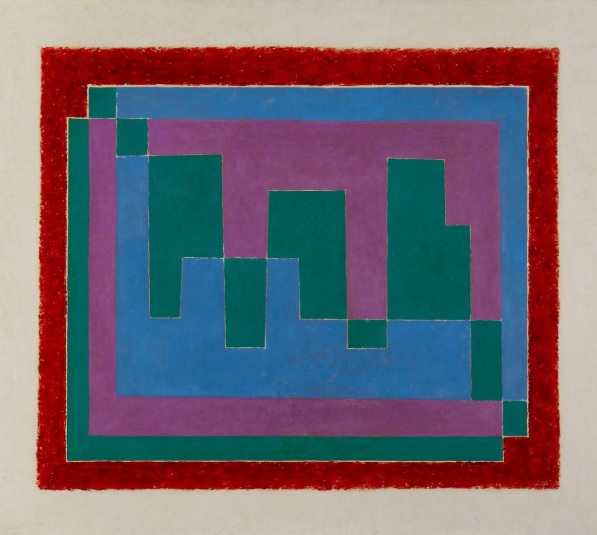
Josef Albers
German, 1888-1976 (active USA)
Mirage (A), 1940
oil on paper pulp board
28 x 31 7/8 in.
SBMA Museum purchase, Donald Bear Memorial Fund
1967.24
COMMENTS
An elementary school teacher for twelve years, and an instructor at the Bauhaus from 1923 until 1933, Josef Albers was one of the most influential artist-educators to immigrate to the United States during the 1930s. Following early academic training at the Royal Art School in Berlin (1913–15), the Kunstgewerbeschule in Essen (part-time from 1916 to 1919), and the Art Academy in Munich (1919–20), Albers turned in 1920 to the innovative atmosphere of the Weimar Bauhaus. There he began his experimental work as an abstract artist. After three years as a student, he was hired to teach the famed Vorkurs, the introductory class that immersed students in the principles of design and the behavior of materials.
Albers was convinced that students needed to develop an understanding of “the static and dynamic properties of materials… through direct experience.” His students made constructions with wire netting, matchboxes, phonograph needles, razor blades, and other unusual materials. They also visited workshops where craftsmen worked daily with the structural and behavioral characteristics of industrial and natural materials.(1)
In his own work, Albers investigated color theory and composition. He began to explore mathematical proportions as a way to achieve balance and unity in his art. Yet, Albers did not aim to be a purely analytical painter. Although he had not taken classes with either Klee or Kandinsky as a Bauhaus student, and did not profess metaphysical concerns, Albers believed that Art is spirit, and only the quality of spirit gives the arts an important place in… life.”(2)
Albers had come to his own brand of abstraction over the course of many years. By 1908, he had discovered Matisse and Cézanne, and in Berlin he encountered work by Munch, van Gogh, the German Expressionists, Delaunay, and the Italian Futurists. Initially an expressionist, Albers began experimenting with abstract principles and unusual materials about 1923. His glass assemblages of these formative years explored the possibilities of stained, sandblasted, and constructed arrangements. They are remarkable for their deft incorporation of such “accidental” effects as ripples and bubblesinherent in the medium itselfinto sophisticateddesigns that explored balance, translucence, and opacity.
Albers had weathered Bauhaus moves from Weimar to Dessau, and then to Berlin, remaining steadfast even after Walter Gropius and Laszlo Moholy-Nagy left in 1928. In 1933, when the Nazis forced the closing of the Berlin Bauhaus, Albers left for America where he introduced Bauhaus concepts of art and design to the newly formed experimental community of Black Mountain College in North Carolina.
After fifteen years he left Black Mountain and, in 1950, became chairman of the Department of Design at Yale. On Tideland, painted between 1947 and 1955, marks this transition and was painted concurrently with the earliest examples of his well-known series, Homage to the Square.
Albers, always a careful craftsman, was concerned that future generations understand his working methods. He often documented, on the reverse of the fiberboard panels he preferred for his paintings, the pigments, brands, varnishes, and grounds he had used in making the painting. Fascinating notations document his spatial proportions and the mathematic schemes he incorporated in each work. On Tideland, for example, was painted according to “Scheme M,” in which twenty units of vertical form balance thirty units of horizontal form. Although concerned with a severely restricted format in his own work, Albers admitted other approaches: “Any form [of art] is acceptable if it is true,” he stated. “And if it is true, it’s ethical and aesthetic.”(3)
An original member of the American Abstract Artists, Albers showed annually throughout the group’s formative years.
Bibliography
1. Josef Albers, Concerning Fundamental Design., in Herbert Bayer, Walter Gropius, and Ise Gropius, eds., Bauhaus: 19191928 (Boston: Charles T Branford Co., 1959), pp.114–21.
2. Josef Albers, “A Note on the Arts inEducation,” American Magazine ofArt (April 1936): 233.
3. Katharine Kuh, “Josef Albers,” in The Artist’s Voice: Talks with Seventeen Artists (New York: Harper and Row, 1962), p.12.
4. Virginia M. Mecklenburg, The Patricia and Phillip Frost Collection: American Abstraction 1930–1945 (Washington, D.C.: Smithsonian Institution Press for the National Museum of American Art, 1989)
- Smithsonian American Art Museum, 1989
https://americanart.si.edu/artist/josef-albers-46
